Importance of Communication, Critical Thinking, Teamwork, and Ethics in Nursing
VerifiedAdded on 2022/11/15
|9
|5244
|237
AI Summary
This article discusses the importance of communication, critical thinking, teamwork, and ethics in nursing. It emphasizes the need for effective communication skills to establish a relationship of trust between medical staff and patients. It also highlights the significance of critical thinking in clinical decision-making, the importance of teamwork in providing quality patient care, and the ethical responsibilities of nurses in their professional practice.
Contribute Materials
Your contribution can guide someone’s learning journey. Share your
documents today.
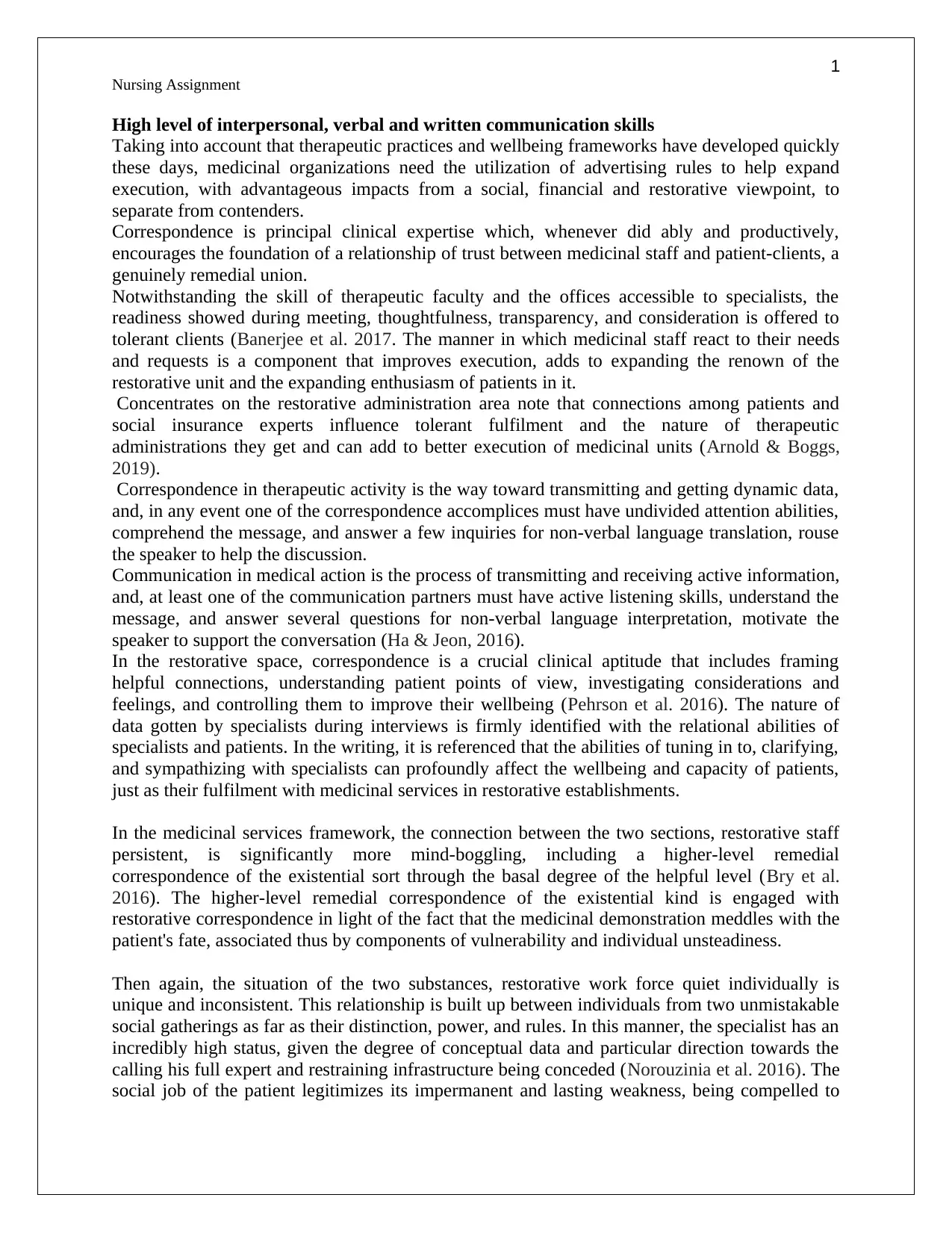
1
Nursing Assignment
High level of interpersonal, verbal and written communication skills
Taking into account that therapeutic practices and wellbeing frameworks have developed quickly
these days, medicinal organizations need the utilization of advertising rules to help expand
execution, with advantageous impacts from a social, financial and restorative viewpoint, to
separate from contenders.
Correspondence is principal clinical expertise which, whenever did ably and productively,
encourages the foundation of a relationship of trust between medicinal staff and patient-clients, a
genuinely remedial union.
Notwithstanding the skill of therapeutic faculty and the offices accessible to specialists, the
readiness showed during meeting, thoughtfulness, transparency, and consideration is offered to
tolerant clients (Banerjee et al. 2017. The manner in which medicinal staff react to their needs
and requests is a component that improves execution, adds to expanding the renown of the
restorative unit and the expanding enthusiasm of patients in it.
Concentrates on the restorative administration area note that connections among patients and
social insurance experts influence tolerant fulfilment and the nature of therapeutic
administrations they get and can add to better execution of medicinal units (Arnold & Boggs,
2019).
Correspondence in therapeutic activity is the way toward transmitting and getting dynamic data,
and, in any event one of the correspondence accomplices must have undivided attention abilities,
comprehend the message, and answer a few inquiries for non-verbal language translation, rouse
the speaker to help the discussion.
Communication in medical action is the process of transmitting and receiving active information,
and, at least one of the communication partners must have active listening skills, understand the
message, and answer several questions for non-verbal language interpretation, motivate the
speaker to support the conversation (Ha & Jeon, 2016).
In the restorative space, correspondence is a crucial clinical aptitude that includes framing
helpful connections, understanding patient points of view, investigating considerations and
feelings, and controlling them to improve their wellbeing (Pehrson et al. 2016). The nature of
data gotten by specialists during interviews is firmly identified with the relational abilities of
specialists and patients. In the writing, it is referenced that the abilities of tuning in to, clarifying,
and sympathizing with specialists can profoundly affect the wellbeing and capacity of patients,
just as their fulfilment with medicinal services in restorative establishments.
In the medicinal services framework, the connection between the two sections, restorative staff
persistent, is significantly more mind-boggling, including a higher-level remedial
correspondence of the existential sort through the basal degree of the helpful level (Bry et al.
2016). The higher-level remedial correspondence of the existential kind is engaged with
restorative correspondence in light of the fact that the medicinal demonstration meddles with the
patient's fate, associated thus by components of vulnerability and individual unsteadiness.
Then again, the situation of the two substances, restorative work force quiet individually is
unique and inconsistent. This relationship is built up between individuals from two unmistakable
social gatherings as far as their distinction, power, and rules. In this manner, the specialist has an
incredibly high status, given the degree of conceptual data and particular direction towards the
calling his full expert and restraining infrastructure being conceded (Norouzinia et al. 2016). The
social job of the patient legitimizes its impermanent and lasting weakness, being compelled to
Nursing Assignment
High level of interpersonal, verbal and written communication skills
Taking into account that therapeutic practices and wellbeing frameworks have developed quickly
these days, medicinal organizations need the utilization of advertising rules to help expand
execution, with advantageous impacts from a social, financial and restorative viewpoint, to
separate from contenders.
Correspondence is principal clinical expertise which, whenever did ably and productively,
encourages the foundation of a relationship of trust between medicinal staff and patient-clients, a
genuinely remedial union.
Notwithstanding the skill of therapeutic faculty and the offices accessible to specialists, the
readiness showed during meeting, thoughtfulness, transparency, and consideration is offered to
tolerant clients (Banerjee et al. 2017. The manner in which medicinal staff react to their needs
and requests is a component that improves execution, adds to expanding the renown of the
restorative unit and the expanding enthusiasm of patients in it.
Concentrates on the restorative administration area note that connections among patients and
social insurance experts influence tolerant fulfilment and the nature of therapeutic
administrations they get and can add to better execution of medicinal units (Arnold & Boggs,
2019).
Correspondence in therapeutic activity is the way toward transmitting and getting dynamic data,
and, in any event one of the correspondence accomplices must have undivided attention abilities,
comprehend the message, and answer a few inquiries for non-verbal language translation, rouse
the speaker to help the discussion.
Communication in medical action is the process of transmitting and receiving active information,
and, at least one of the communication partners must have active listening skills, understand the
message, and answer several questions for non-verbal language interpretation, motivate the
speaker to support the conversation (Ha & Jeon, 2016).
In the restorative space, correspondence is a crucial clinical aptitude that includes framing
helpful connections, understanding patient points of view, investigating considerations and
feelings, and controlling them to improve their wellbeing (Pehrson et al. 2016). The nature of
data gotten by specialists during interviews is firmly identified with the relational abilities of
specialists and patients. In the writing, it is referenced that the abilities of tuning in to, clarifying,
and sympathizing with specialists can profoundly affect the wellbeing and capacity of patients,
just as their fulfilment with medicinal services in restorative establishments.
In the medicinal services framework, the connection between the two sections, restorative staff
persistent, is significantly more mind-boggling, including a higher-level remedial
correspondence of the existential sort through the basal degree of the helpful level (Bry et al.
2016). The higher-level remedial correspondence of the existential kind is engaged with
restorative correspondence in light of the fact that the medicinal demonstration meddles with the
patient's fate, associated thus by components of vulnerability and individual unsteadiness.
Then again, the situation of the two substances, restorative work force quiet individually is
unique and inconsistent. This relationship is built up between individuals from two unmistakable
social gatherings as far as their distinction, power, and rules. In this manner, the specialist has an
incredibly high status, given the degree of conceptual data and particular direction towards the
calling his full expert and restraining infrastructure being conceded (Norouzinia et al. 2016). The
social job of the patient legitimizes its impermanent and lasting weakness, being compelled to
Secure Best Marks with AI Grader
Need help grading? Try our AI Grader for instant feedback on your assignments.
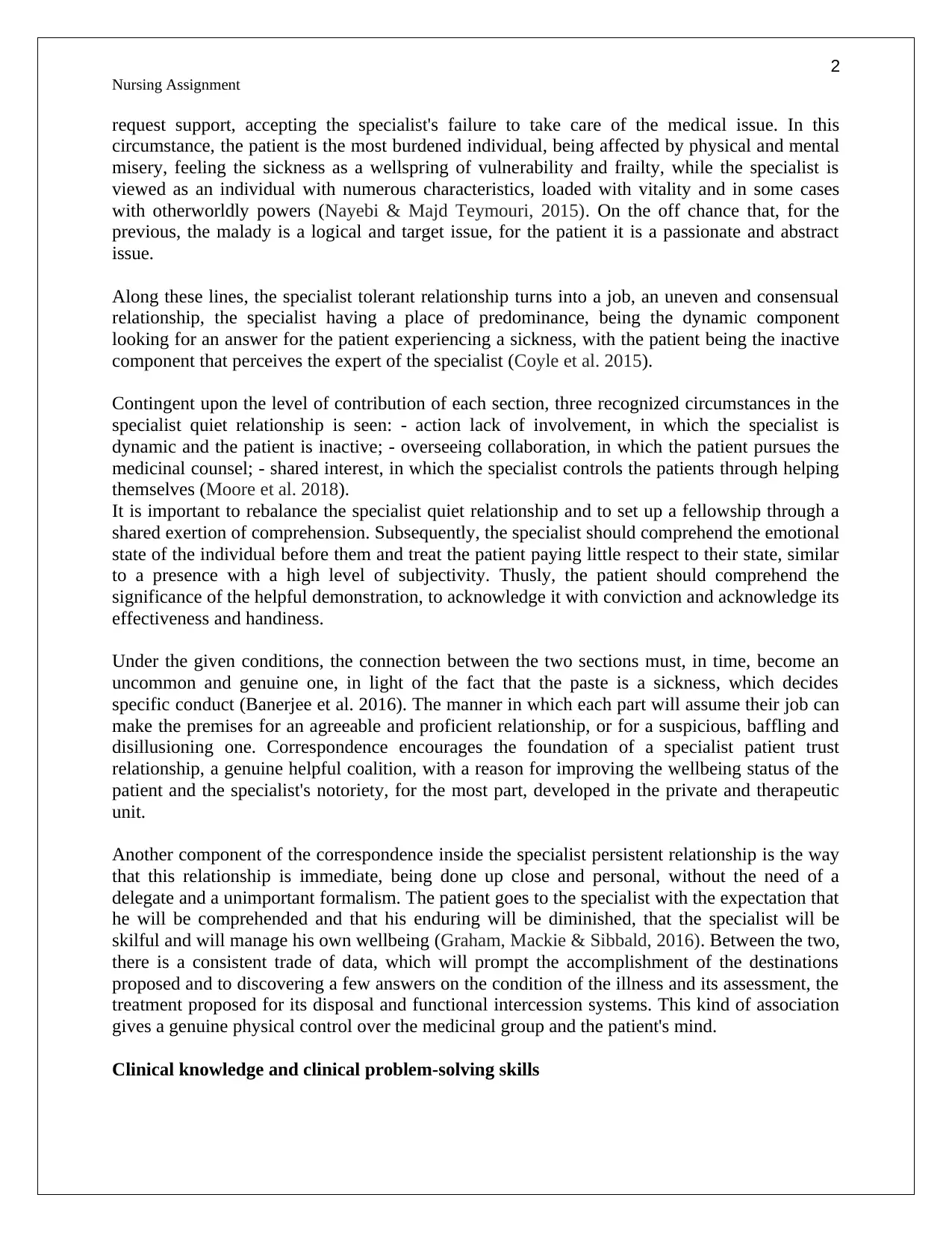
2
Nursing Assignment
request support, accepting the specialist's failure to take care of the medical issue. In this
circumstance, the patient is the most burdened individual, being affected by physical and mental
misery, feeling the sickness as a wellspring of vulnerability and frailty, while the specialist is
viewed as an individual with numerous characteristics, loaded with vitality and in some cases
with otherworldly powers (Nayebi & Majd Teymouri, 2015). On the off chance that, for the
previous, the malady is a logical and target issue, for the patient it is a passionate and abstract
issue.
Along these lines, the specialist tolerant relationship turns into a job, an uneven and consensual
relationship, the specialist having a place of predominance, being the dynamic component
looking for an answer for the patient experiencing a sickness, with the patient being the inactive
component that perceives the expert of the specialist (Coyle et al. 2015).
Contingent upon the level of contribution of each section, three recognized circumstances in the
specialist quiet relationship is seen: - action lack of involvement, in which the specialist is
dynamic and the patient is inactive; - overseeing collaboration, in which the patient pursues the
medicinal counsel; - shared interest, in which the specialist controls the patients through helping
themselves (Moore et al. 2018).
It is important to rebalance the specialist quiet relationship and to set up a fellowship through a
shared exertion of comprehension. Subsequently, the specialist should comprehend the emotional
state of the individual before them and treat the patient paying little respect to their state, similar
to a presence with a high level of subjectivity. Thusly, the patient should comprehend the
significance of the helpful demonstration, to acknowledge it with conviction and acknowledge its
effectiveness and handiness.
Under the given conditions, the connection between the two sections must, in time, become an
uncommon and genuine one, in light of the fact that the paste is a sickness, which decides
specific conduct (Banerjee et al. 2016). The manner in which each part will assume their job can
make the premises for an agreeable and proficient relationship, or for a suspicious, baffling and
disillusioning one. Correspondence encourages the foundation of a specialist patient trust
relationship, a genuine helpful coalition, with a reason for improving the wellbeing status of the
patient and the specialist's notoriety, for the most part, developed in the private and therapeutic
unit.
Another component of the correspondence inside the specialist persistent relationship is the way
that this relationship is immediate, being done up close and personal, without the need of a
delegate and a unimportant formalism. The patient goes to the specialist with the expectation that
he will be comprehended and that his enduring will be diminished, that the specialist will be
skilful and will manage his own wellbeing (Graham, Mackie & Sibbald, 2016). Between the two,
there is a consistent trade of data, which will prompt the accomplishment of the destinations
proposed and to discovering a few answers on the condition of the illness and its assessment, the
treatment proposed for its disposal and functional intercession systems. This kind of association
gives a genuine physical control over the medicinal group and the patient's mind.
Clinical knowledge and clinical problem-solving skills
Nursing Assignment
request support, accepting the specialist's failure to take care of the medical issue. In this
circumstance, the patient is the most burdened individual, being affected by physical and mental
misery, feeling the sickness as a wellspring of vulnerability and frailty, while the specialist is
viewed as an individual with numerous characteristics, loaded with vitality and in some cases
with otherworldly powers (Nayebi & Majd Teymouri, 2015). On the off chance that, for the
previous, the malady is a logical and target issue, for the patient it is a passionate and abstract
issue.
Along these lines, the specialist tolerant relationship turns into a job, an uneven and consensual
relationship, the specialist having a place of predominance, being the dynamic component
looking for an answer for the patient experiencing a sickness, with the patient being the inactive
component that perceives the expert of the specialist (Coyle et al. 2015).
Contingent upon the level of contribution of each section, three recognized circumstances in the
specialist quiet relationship is seen: - action lack of involvement, in which the specialist is
dynamic and the patient is inactive; - overseeing collaboration, in which the patient pursues the
medicinal counsel; - shared interest, in which the specialist controls the patients through helping
themselves (Moore et al. 2018).
It is important to rebalance the specialist quiet relationship and to set up a fellowship through a
shared exertion of comprehension. Subsequently, the specialist should comprehend the emotional
state of the individual before them and treat the patient paying little respect to their state, similar
to a presence with a high level of subjectivity. Thusly, the patient should comprehend the
significance of the helpful demonstration, to acknowledge it with conviction and acknowledge its
effectiveness and handiness.
Under the given conditions, the connection between the two sections must, in time, become an
uncommon and genuine one, in light of the fact that the paste is a sickness, which decides
specific conduct (Banerjee et al. 2016). The manner in which each part will assume their job can
make the premises for an agreeable and proficient relationship, or for a suspicious, baffling and
disillusioning one. Correspondence encourages the foundation of a specialist patient trust
relationship, a genuine helpful coalition, with a reason for improving the wellbeing status of the
patient and the specialist's notoriety, for the most part, developed in the private and therapeutic
unit.
Another component of the correspondence inside the specialist persistent relationship is the way
that this relationship is immediate, being done up close and personal, without the need of a
delegate and a unimportant formalism. The patient goes to the specialist with the expectation that
he will be comprehended and that his enduring will be diminished, that the specialist will be
skilful and will manage his own wellbeing (Graham, Mackie & Sibbald, 2016). Between the two,
there is a consistent trade of data, which will prompt the accomplishment of the destinations
proposed and to discovering a few answers on the condition of the illness and its assessment, the
treatment proposed for its disposal and functional intercession systems. This kind of association
gives a genuine physical control over the medicinal group and the patient's mind.
Clinical knowledge and clinical problem-solving skills
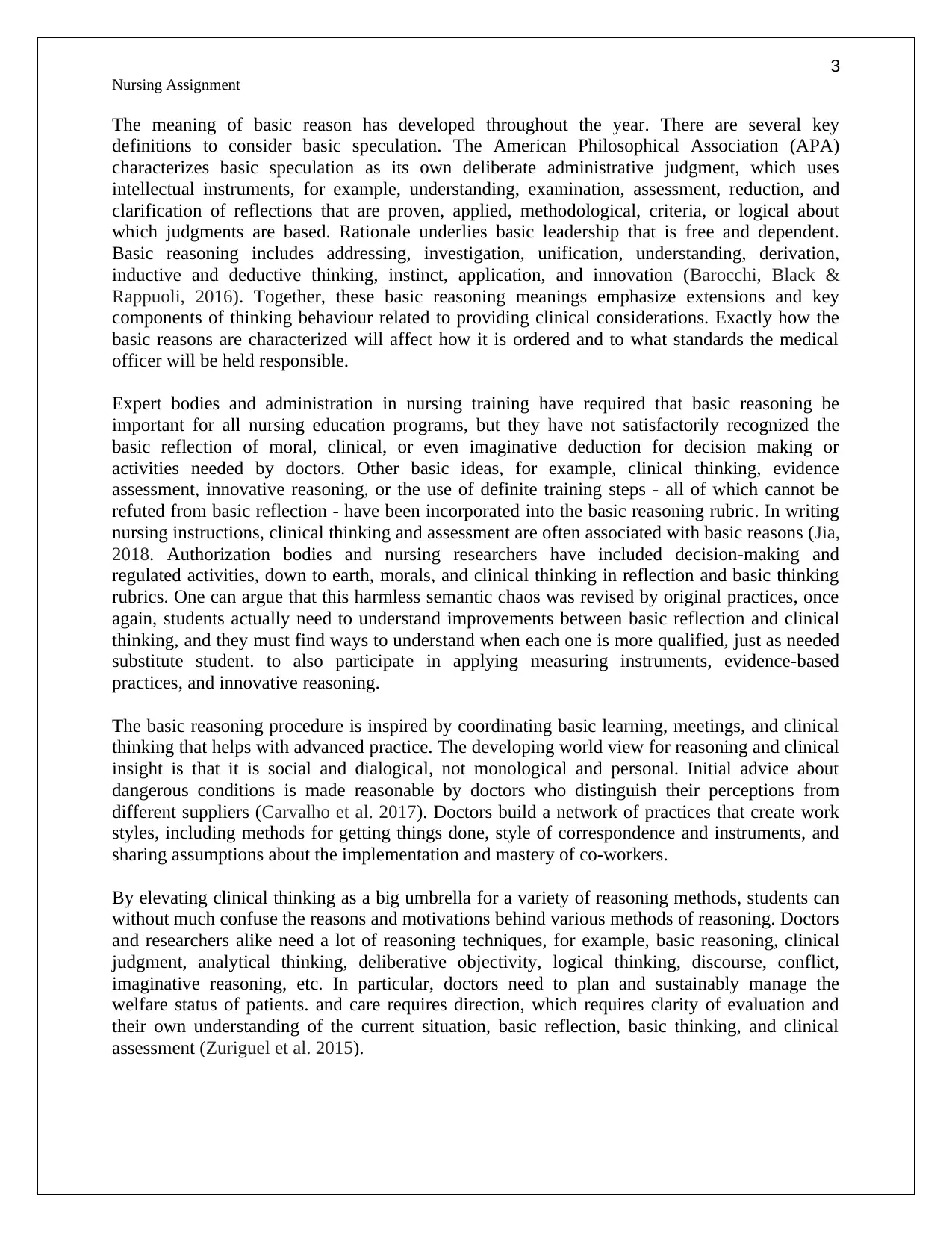
3
Nursing Assignment
The meaning of basic reason has developed throughout the year. There are several key
definitions to consider basic speculation. The American Philosophical Association (APA)
characterizes basic speculation as its own deliberate administrative judgment, which uses
intellectual instruments, for example, understanding, examination, assessment, reduction, and
clarification of reflections that are proven, applied, methodological, criteria, or logical about
which judgments are based. Rationale underlies basic leadership that is free and dependent.
Basic reasoning includes addressing, investigation, unification, understanding, derivation,
inductive and deductive thinking, instinct, application, and innovation (Barocchi, Black &
Rappuoli, 2016). Together, these basic reasoning meanings emphasize extensions and key
components of thinking behaviour related to providing clinical considerations. Exactly how the
basic reasons are characterized will affect how it is ordered and to what standards the medical
officer will be held responsible.
Expert bodies and administration in nursing training have required that basic reasoning be
important for all nursing education programs, but they have not satisfactorily recognized the
basic reflection of moral, clinical, or even imaginative deduction for decision making or
activities needed by doctors. Other basic ideas, for example, clinical thinking, evidence
assessment, innovative reasoning, or the use of definite training steps - all of which cannot be
refuted from basic reflection - have been incorporated into the basic reasoning rubric. In writing
nursing instructions, clinical thinking and assessment are often associated with basic reasons (Jia,
2018. Authorization bodies and nursing researchers have included decision-making and
regulated activities, down to earth, morals, and clinical thinking in reflection and basic thinking
rubrics. One can argue that this harmless semantic chaos was revised by original practices, once
again, students actually need to understand improvements between basic reflection and clinical
thinking, and they must find ways to understand when each one is more qualified, just as needed
substitute student. to also participate in applying measuring instruments, evidence-based
practices, and innovative reasoning.
The basic reasoning procedure is inspired by coordinating basic learning, meetings, and clinical
thinking that helps with advanced practice. The developing world view for reasoning and clinical
insight is that it is social and dialogical, not monological and personal. Initial advice about
dangerous conditions is made reasonable by doctors who distinguish their perceptions from
different suppliers (Carvalho et al. 2017). Doctors build a network of practices that create work
styles, including methods for getting things done, style of correspondence and instruments, and
sharing assumptions about the implementation and mastery of co-workers.
By elevating clinical thinking as a big umbrella for a variety of reasoning methods, students can
without much confuse the reasons and motivations behind various methods of reasoning. Doctors
and researchers alike need a lot of reasoning techniques, for example, basic reasoning, clinical
judgment, analytical thinking, deliberative objectivity, logical thinking, discourse, conflict,
imaginative reasoning, etc. In particular, doctors need to plan and sustainably manage the
welfare status of patients. and care requires direction, which requires clarity of evaluation and
their own understanding of the current situation, basic reflection, basic thinking, and clinical
assessment (Zuriguel et al. 2015).
Nursing Assignment
The meaning of basic reason has developed throughout the year. There are several key
definitions to consider basic speculation. The American Philosophical Association (APA)
characterizes basic speculation as its own deliberate administrative judgment, which uses
intellectual instruments, for example, understanding, examination, assessment, reduction, and
clarification of reflections that are proven, applied, methodological, criteria, or logical about
which judgments are based. Rationale underlies basic leadership that is free and dependent.
Basic reasoning includes addressing, investigation, unification, understanding, derivation,
inductive and deductive thinking, instinct, application, and innovation (Barocchi, Black &
Rappuoli, 2016). Together, these basic reasoning meanings emphasize extensions and key
components of thinking behaviour related to providing clinical considerations. Exactly how the
basic reasons are characterized will affect how it is ordered and to what standards the medical
officer will be held responsible.
Expert bodies and administration in nursing training have required that basic reasoning be
important for all nursing education programs, but they have not satisfactorily recognized the
basic reflection of moral, clinical, or even imaginative deduction for decision making or
activities needed by doctors. Other basic ideas, for example, clinical thinking, evidence
assessment, innovative reasoning, or the use of definite training steps - all of which cannot be
refuted from basic reflection - have been incorporated into the basic reasoning rubric. In writing
nursing instructions, clinical thinking and assessment are often associated with basic reasons (Jia,
2018. Authorization bodies and nursing researchers have included decision-making and
regulated activities, down to earth, morals, and clinical thinking in reflection and basic thinking
rubrics. One can argue that this harmless semantic chaos was revised by original practices, once
again, students actually need to understand improvements between basic reflection and clinical
thinking, and they must find ways to understand when each one is more qualified, just as needed
substitute student. to also participate in applying measuring instruments, evidence-based
practices, and innovative reasoning.
The basic reasoning procedure is inspired by coordinating basic learning, meetings, and clinical
thinking that helps with advanced practice. The developing world view for reasoning and clinical
insight is that it is social and dialogical, not monological and personal. Initial advice about
dangerous conditions is made reasonable by doctors who distinguish their perceptions from
different suppliers (Carvalho et al. 2017). Doctors build a network of practices that create work
styles, including methods for getting things done, style of correspondence and instruments, and
sharing assumptions about the implementation and mastery of co-workers.
By elevating clinical thinking as a big umbrella for a variety of reasoning methods, students can
without much confuse the reasons and motivations behind various methods of reasoning. Doctors
and researchers alike need a lot of reasoning techniques, for example, basic reasoning, clinical
judgment, analytical thinking, deliberative objectivity, logical thinking, discourse, conflict,
imaginative reasoning, etc. In particular, doctors need to plan and sustainably manage the
welfare status of patients. and care requires direction, which requires clarity of evaluation and
their own understanding of the current situation, basic reflection, basic thinking, and clinical
assessment (Zuriguel et al. 2015).
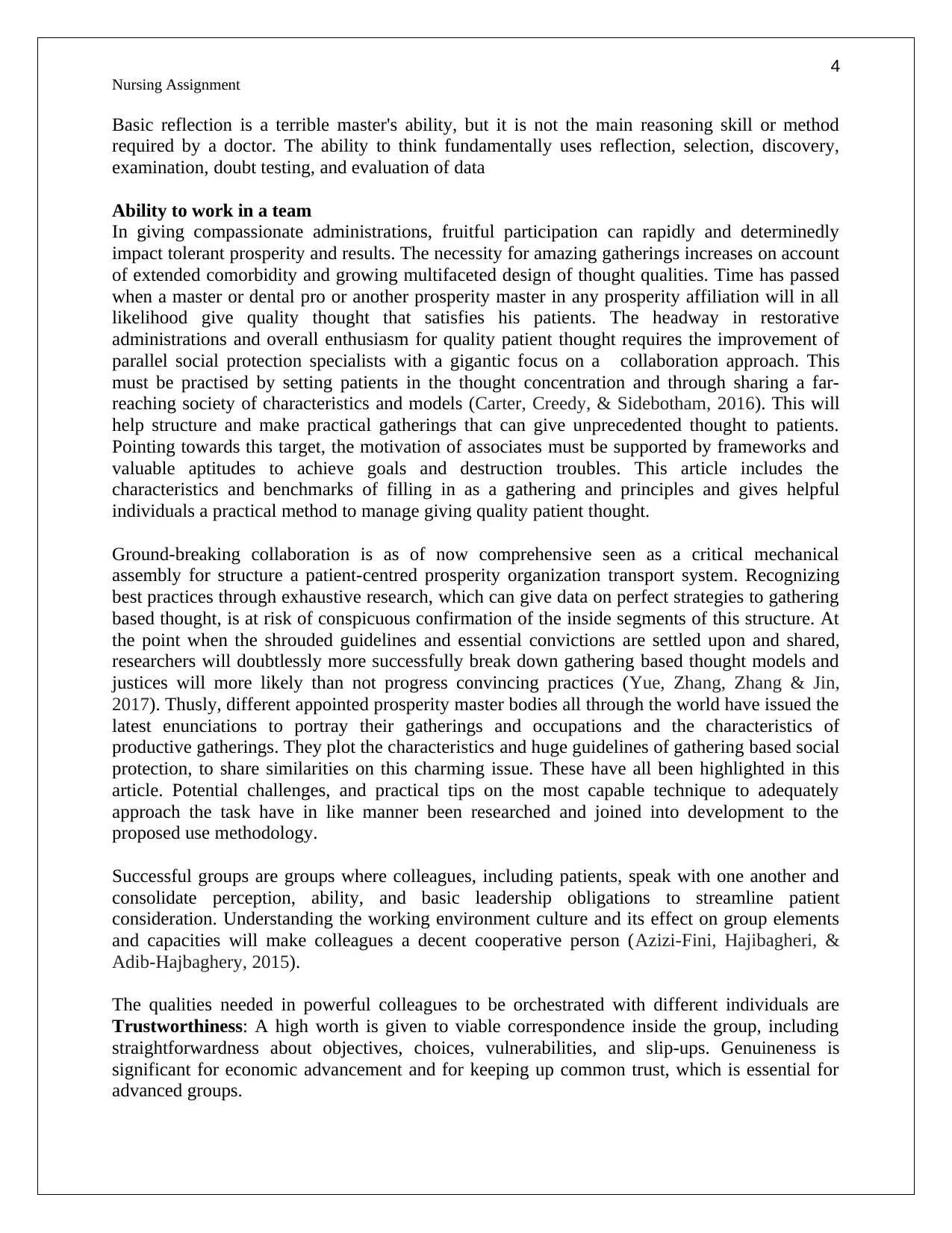
4
Nursing Assignment
Basic reflection is a terrible master's ability, but it is not the main reasoning skill or method
required by a doctor. The ability to think fundamentally uses reflection, selection, discovery,
examination, doubt testing, and evaluation of data
Ability to work in a team
In giving compassionate administrations, fruitful participation can rapidly and determinedly
impact tolerant prosperity and results. The necessity for amazing gatherings increases on account
of extended comorbidity and growing multifaceted design of thought qualities. Time has passed
when a master or dental pro or another prosperity master in any prosperity affiliation will in all
likelihood give quality thought that satisfies his patients. The headway in restorative
administrations and overall enthusiasm for quality patient thought requires the improvement of
parallel social protection specialists with a gigantic focus on a collaboration approach. This
must be practised by setting patients in the thought concentration and through sharing a far-
reaching society of characteristics and models (Carter, Creedy, & Sidebotham, 2016). This will
help structure and make practical gatherings that can give unprecedented thought to patients.
Pointing towards this target, the motivation of associates must be supported by frameworks and
valuable aptitudes to achieve goals and destruction troubles. This article includes the
characteristics and benchmarks of filling in as a gathering and principles and gives helpful
individuals a practical method to manage giving quality patient thought.
Ground-breaking collaboration is as of now comprehensive seen as a critical mechanical
assembly for structure a patient-centred prosperity organization transport system. Recognizing
best practices through exhaustive research, which can give data on perfect strategies to gathering
based thought, is at risk of conspicuous confirmation of the inside segments of this structure. At
the point when the shrouded guidelines and essential convictions are settled upon and shared,
researchers will doubtlessly more successfully break down gathering based thought models and
justices will more likely than not progress convincing practices (Yue, Zhang, Zhang & Jin,
2017). Thusly, different appointed prosperity master bodies all through the world have issued the
latest enunciations to portray their gatherings and occupations and the characteristics of
productive gatherings. They plot the characteristics and huge guidelines of gathering based social
protection, to share similarities on this charming issue. These have all been highlighted in this
article. Potential challenges, and practical tips on the most capable technique to adequately
approach the task have in like manner been researched and joined into development to the
proposed use methodology.
Successful groups are groups where colleagues, including patients, speak with one another and
consolidate perception, ability, and basic leadership obligations to streamline patient
consideration. Understanding the working environment culture and its effect on group elements
and capacities will make colleagues a decent cooperative person (Azizi-Fini, Hajibagheri, &
Adib-Hajbaghery, 2015).
The qualities needed in powerful colleagues to be orchestrated with different individuals are
Trustworthiness: A high worth is given to viable correspondence inside the group, including
straightforwardness about objectives, choices, vulnerabilities, and slip-ups. Genuineness is
significant for economic advancement and for keeping up common trust, which is essential for
advanced groups.
Nursing Assignment
Basic reflection is a terrible master's ability, but it is not the main reasoning skill or method
required by a doctor. The ability to think fundamentally uses reflection, selection, discovery,
examination, doubt testing, and evaluation of data
Ability to work in a team
In giving compassionate administrations, fruitful participation can rapidly and determinedly
impact tolerant prosperity and results. The necessity for amazing gatherings increases on account
of extended comorbidity and growing multifaceted design of thought qualities. Time has passed
when a master or dental pro or another prosperity master in any prosperity affiliation will in all
likelihood give quality thought that satisfies his patients. The headway in restorative
administrations and overall enthusiasm for quality patient thought requires the improvement of
parallel social protection specialists with a gigantic focus on a collaboration approach. This
must be practised by setting patients in the thought concentration and through sharing a far-
reaching society of characteristics and models (Carter, Creedy, & Sidebotham, 2016). This will
help structure and make practical gatherings that can give unprecedented thought to patients.
Pointing towards this target, the motivation of associates must be supported by frameworks and
valuable aptitudes to achieve goals and destruction troubles. This article includes the
characteristics and benchmarks of filling in as a gathering and principles and gives helpful
individuals a practical method to manage giving quality patient thought.
Ground-breaking collaboration is as of now comprehensive seen as a critical mechanical
assembly for structure a patient-centred prosperity organization transport system. Recognizing
best practices through exhaustive research, which can give data on perfect strategies to gathering
based thought, is at risk of conspicuous confirmation of the inside segments of this structure. At
the point when the shrouded guidelines and essential convictions are settled upon and shared,
researchers will doubtlessly more successfully break down gathering based thought models and
justices will more likely than not progress convincing practices (Yue, Zhang, Zhang & Jin,
2017). Thusly, different appointed prosperity master bodies all through the world have issued the
latest enunciations to portray their gatherings and occupations and the characteristics of
productive gatherings. They plot the characteristics and huge guidelines of gathering based social
protection, to share similarities on this charming issue. These have all been highlighted in this
article. Potential challenges, and practical tips on the most capable technique to adequately
approach the task have in like manner been researched and joined into development to the
proposed use methodology.
Successful groups are groups where colleagues, including patients, speak with one another and
consolidate perception, ability, and basic leadership obligations to streamline patient
consideration. Understanding the working environment culture and its effect on group elements
and capacities will make colleagues a decent cooperative person (Azizi-Fini, Hajibagheri, &
Adib-Hajbaghery, 2015).
The qualities needed in powerful colleagues to be orchestrated with different individuals are
Trustworthiness: A high worth is given to viable correspondence inside the group, including
straightforwardness about objectives, choices, vulnerabilities, and slip-ups. Genuineness is
significant for economic advancement and for keeping up common trust, which is essential for
advanced groups.
Secure Best Marks with AI Grader
Need help grading? Try our AI Grader for instant feedback on your assignments.
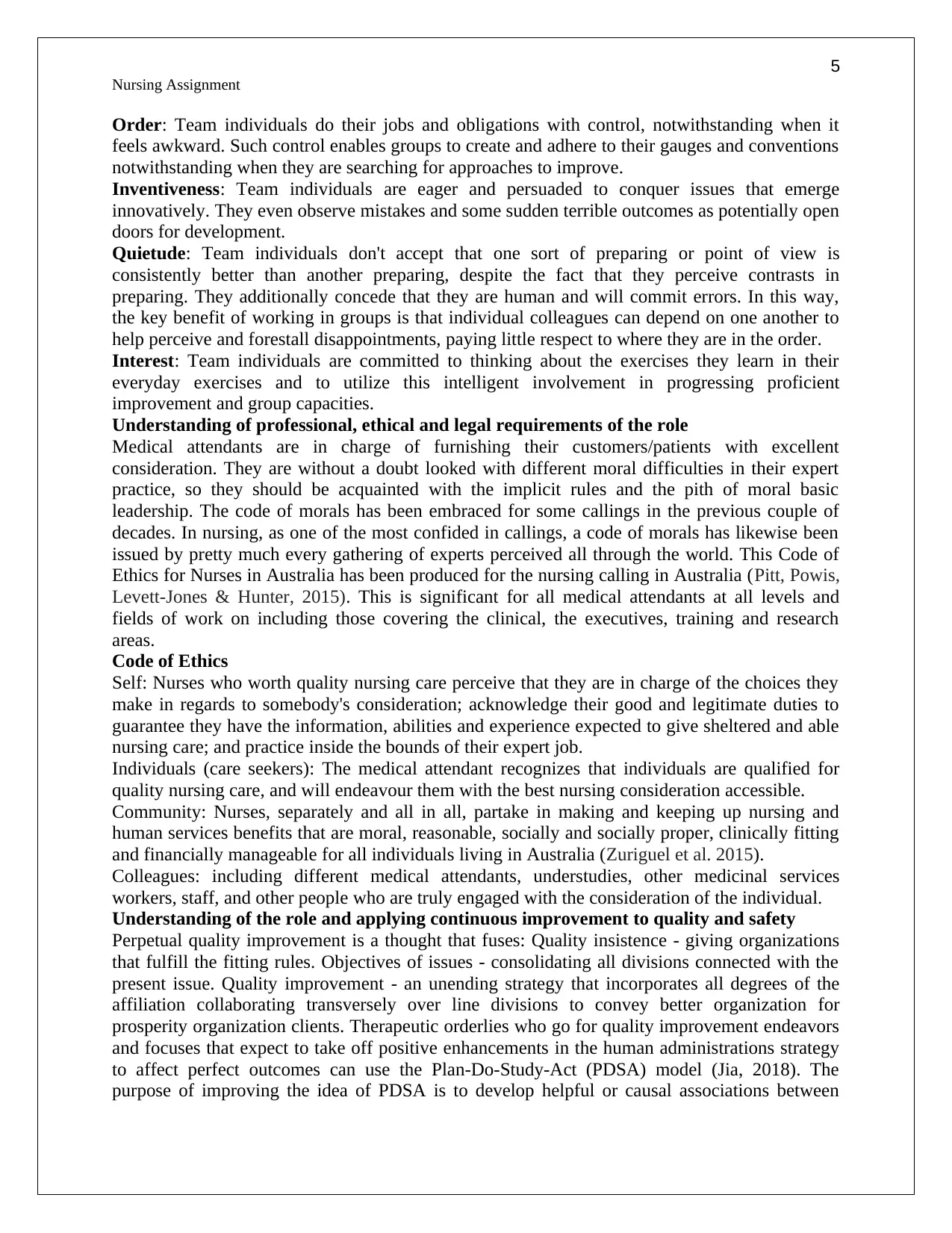
5
Nursing Assignment
Order: Team individuals do their jobs and obligations with control, notwithstanding when it
feels awkward. Such control enables groups to create and adhere to their gauges and conventions
notwithstanding when they are searching for approaches to improve.
Inventiveness: Team individuals are eager and persuaded to conquer issues that emerge
innovatively. They even observe mistakes and some sudden terrible outcomes as potentially open
doors for development.
Quietude: Team individuals don't accept that one sort of preparing or point of view is
consistently better than another preparing, despite the fact that they perceive contrasts in
preparing. They additionally concede that they are human and will commit errors. In this way,
the key benefit of working in groups is that individual colleagues can depend on one another to
help perceive and forestall disappointments, paying little respect to where they are in the order.
Interest: Team individuals are committed to thinking about the exercises they learn in their
everyday exercises and to utilize this intelligent involvement in progressing proficient
improvement and group capacities.
Understanding of professional, ethical and legal requirements of the role
Medical attendants are in charge of furnishing their customers/patients with excellent
consideration. They are without a doubt looked with different moral difficulties in their expert
practice, so they should be acquainted with the implicit rules and the pith of moral basic
leadership. The code of morals has been embraced for some callings in the previous couple of
decades. In nursing, as one of the most confided in callings, a code of morals has likewise been
issued by pretty much every gathering of experts perceived all through the world. This Code of
Ethics for Nurses in Australia has been produced for the nursing calling in Australia (Pitt, Powis,
Levett-Jones & Hunter, 2015). This is significant for all medical attendants at all levels and
fields of work on including those covering the clinical, the executives, training and research
areas.
Code of Ethics
Self: Nurses who worth quality nursing care perceive that they are in charge of the choices they
make in regards to somebody's consideration; acknowledge their good and legitimate duties to
guarantee they have the information, abilities and experience expected to give sheltered and able
nursing care; and practice inside the bounds of their expert job.
Individuals (care seekers): The medical attendant recognizes that individuals are qualified for
quality nursing care, and will endeavour them with the best nursing consideration accessible.
Community: Nurses, separately and all in all, partake in making and keeping up nursing and
human services benefits that are moral, reasonable, socially and socially proper, clinically fitting
and financially manageable for all individuals living in Australia (Zuriguel et al. 2015).
Colleagues: including different medical attendants, understudies, other medicinal services
workers, staff, and other people who are truly engaged with the consideration of the individual.
Understanding of the role and applying continuous improvement to quality and safety
Perpetual quality improvement is a thought that fuses: Quality insistence - giving organizations
that fulfill the fitting rules. Objectives of issues - consolidating all divisions connected with the
present issue. Quality improvement - an unending strategy that incorporates all degrees of the
affiliation collaborating transversely over line divisions to convey better organization for
prosperity organization clients. Therapeutic orderlies who go for quality improvement endeavors
and focuses that expect to take off positive enhancements in the human administrations strategy
to affect perfect outcomes can use the Plan-Do-Study-Act (PDSA) model (Jia, 2018). The
purpose of improving the idea of PDSA is to develop helpful or causal associations between
Nursing Assignment
Order: Team individuals do their jobs and obligations with control, notwithstanding when it
feels awkward. Such control enables groups to create and adhere to their gauges and conventions
notwithstanding when they are searching for approaches to improve.
Inventiveness: Team individuals are eager and persuaded to conquer issues that emerge
innovatively. They even observe mistakes and some sudden terrible outcomes as potentially open
doors for development.
Quietude: Team individuals don't accept that one sort of preparing or point of view is
consistently better than another preparing, despite the fact that they perceive contrasts in
preparing. They additionally concede that they are human and will commit errors. In this way,
the key benefit of working in groups is that individual colleagues can depend on one another to
help perceive and forestall disappointments, paying little respect to where they are in the order.
Interest: Team individuals are committed to thinking about the exercises they learn in their
everyday exercises and to utilize this intelligent involvement in progressing proficient
improvement and group capacities.
Understanding of professional, ethical and legal requirements of the role
Medical attendants are in charge of furnishing their customers/patients with excellent
consideration. They are without a doubt looked with different moral difficulties in their expert
practice, so they should be acquainted with the implicit rules and the pith of moral basic
leadership. The code of morals has been embraced for some callings in the previous couple of
decades. In nursing, as one of the most confided in callings, a code of morals has likewise been
issued by pretty much every gathering of experts perceived all through the world. This Code of
Ethics for Nurses in Australia has been produced for the nursing calling in Australia (Pitt, Powis,
Levett-Jones & Hunter, 2015). This is significant for all medical attendants at all levels and
fields of work on including those covering the clinical, the executives, training and research
areas.
Code of Ethics
Self: Nurses who worth quality nursing care perceive that they are in charge of the choices they
make in regards to somebody's consideration; acknowledge their good and legitimate duties to
guarantee they have the information, abilities and experience expected to give sheltered and able
nursing care; and practice inside the bounds of their expert job.
Individuals (care seekers): The medical attendant recognizes that individuals are qualified for
quality nursing care, and will endeavour them with the best nursing consideration accessible.
Community: Nurses, separately and all in all, partake in making and keeping up nursing and
human services benefits that are moral, reasonable, socially and socially proper, clinically fitting
and financially manageable for all individuals living in Australia (Zuriguel et al. 2015).
Colleagues: including different medical attendants, understudies, other medicinal services
workers, staff, and other people who are truly engaged with the consideration of the individual.
Understanding of the role and applying continuous improvement to quality and safety
Perpetual quality improvement is a thought that fuses: Quality insistence - giving organizations
that fulfill the fitting rules. Objectives of issues - consolidating all divisions connected with the
present issue. Quality improvement - an unending strategy that incorporates all degrees of the
affiliation collaborating transversely over line divisions to convey better organization for
prosperity organization clients. Therapeutic orderlies who go for quality improvement endeavors
and focuses that expect to take off positive enhancements in the human administrations strategy
to affect perfect outcomes can use the Plan-Do-Study-Act (PDSA) model (Jia, 2018). The
purpose of improving the idea of PDSA is to develop helpful or causal associations between
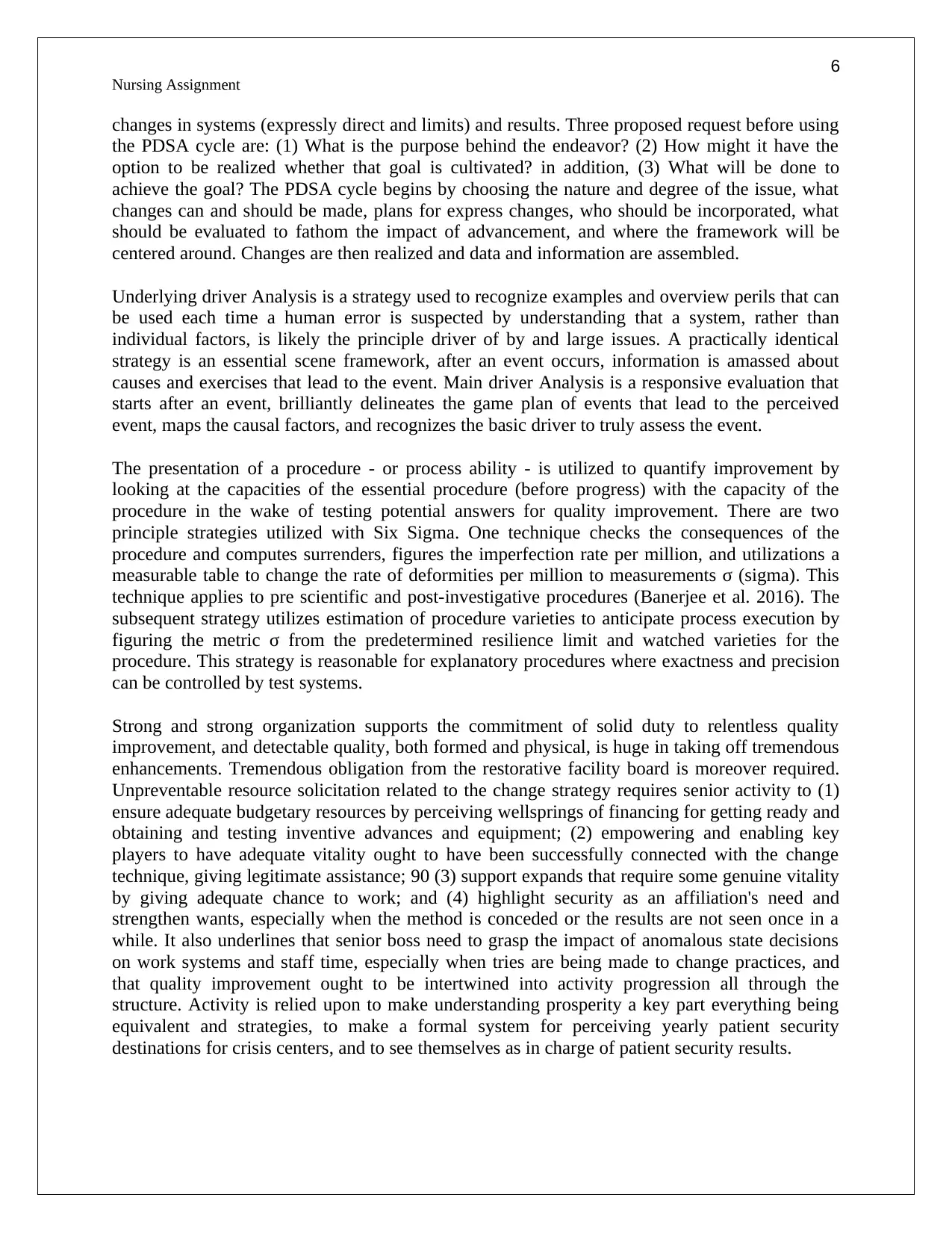
6
Nursing Assignment
changes in systems (expressly direct and limits) and results. Three proposed request before using
the PDSA cycle are: (1) What is the purpose behind the endeavor? (2) How might it have the
option to be realized whether that goal is cultivated? in addition, (3) What will be done to
achieve the goal? The PDSA cycle begins by choosing the nature and degree of the issue, what
changes can and should be made, plans for express changes, who should be incorporated, what
should be evaluated to fathom the impact of advancement, and where the framework will be
centered around. Changes are then realized and data and information are assembled.
Underlying driver Analysis is a strategy used to recognize examples and overview perils that can
be used each time a human error is suspected by understanding that a system, rather than
individual factors, is likely the principle driver of by and large issues. A practically identical
strategy is an essential scene framework, after an event occurs, information is amassed about
causes and exercises that lead to the event. Main driver Analysis is a responsive evaluation that
starts after an event, brilliantly delineates the game plan of events that lead to the perceived
event, maps the causal factors, and recognizes the basic driver to truly assess the event.
The presentation of a procedure - or process ability - is utilized to quantify improvement by
looking at the capacities of the essential procedure (before progress) with the capacity of the
procedure in the wake of testing potential answers for quality improvement. There are two
principle strategies utilized with Six Sigma. One technique checks the consequences of the
procedure and computes surrenders, figures the imperfection rate per million, and utilizations a
measurable table to change the rate of deformities per million to measurements σ (sigma). This
technique applies to pre scientific and post-investigative procedures (Banerjee et al. 2016). The
subsequent strategy utilizes estimation of procedure varieties to anticipate process execution by
figuring the metric σ from the predetermined resilience limit and watched varieties for the
procedure. This strategy is reasonable for explanatory procedures where exactness and precision
can be controlled by test systems.
Strong and strong organization supports the commitment of solid duty to relentless quality
improvement, and detectable quality, both formed and physical, is huge in taking off tremendous
enhancements. Tremendous obligation from the restorative facility board is moreover required.
Unpreventable resource solicitation related to the change strategy requires senior activity to (1)
ensure adequate budgetary resources by perceiving wellsprings of financing for getting ready and
obtaining and testing inventive advances and equipment; (2) empowering and enabling key
players to have adequate vitality ought to have been successfully connected with the change
technique, giving legitimate assistance; 90 (3) support expands that require some genuine vitality
by giving adequate chance to work; and (4) highlight security as an affiliation's need and
strengthen wants, especially when the method is conceded or the results are not seen once in a
while. It also underlines that senior boss need to grasp the impact of anomalous state decisions
on work systems and staff time, especially when tries are being made to change practices, and
that quality improvement ought to be intertwined into activity progression all through the
structure. Activity is relied upon to make understanding prosperity a key part everything being
equivalent and strategies, to make a formal system for perceiving yearly patient security
destinations for crisis centers, and to see themselves as in charge of patient security results.
Nursing Assignment
changes in systems (expressly direct and limits) and results. Three proposed request before using
the PDSA cycle are: (1) What is the purpose behind the endeavor? (2) How might it have the
option to be realized whether that goal is cultivated? in addition, (3) What will be done to
achieve the goal? The PDSA cycle begins by choosing the nature and degree of the issue, what
changes can and should be made, plans for express changes, who should be incorporated, what
should be evaluated to fathom the impact of advancement, and where the framework will be
centered around. Changes are then realized and data and information are assembled.
Underlying driver Analysis is a strategy used to recognize examples and overview perils that can
be used each time a human error is suspected by understanding that a system, rather than
individual factors, is likely the principle driver of by and large issues. A practically identical
strategy is an essential scene framework, after an event occurs, information is amassed about
causes and exercises that lead to the event. Main driver Analysis is a responsive evaluation that
starts after an event, brilliantly delineates the game plan of events that lead to the perceived
event, maps the causal factors, and recognizes the basic driver to truly assess the event.
The presentation of a procedure - or process ability - is utilized to quantify improvement by
looking at the capacities of the essential procedure (before progress) with the capacity of the
procedure in the wake of testing potential answers for quality improvement. There are two
principle strategies utilized with Six Sigma. One technique checks the consequences of the
procedure and computes surrenders, figures the imperfection rate per million, and utilizations a
measurable table to change the rate of deformities per million to measurements σ (sigma). This
technique applies to pre scientific and post-investigative procedures (Banerjee et al. 2016). The
subsequent strategy utilizes estimation of procedure varieties to anticipate process execution by
figuring the metric σ from the predetermined resilience limit and watched varieties for the
procedure. This strategy is reasonable for explanatory procedures where exactness and precision
can be controlled by test systems.
Strong and strong organization supports the commitment of solid duty to relentless quality
improvement, and detectable quality, both formed and physical, is huge in taking off tremendous
enhancements. Tremendous obligation from the restorative facility board is moreover required.
Unpreventable resource solicitation related to the change strategy requires senior activity to (1)
ensure adequate budgetary resources by perceiving wellsprings of financing for getting ready and
obtaining and testing inventive advances and equipment; (2) empowering and enabling key
players to have adequate vitality ought to have been successfully connected with the change
technique, giving legitimate assistance; 90 (3) support expands that require some genuine vitality
by giving adequate chance to work; and (4) highlight security as an affiliation's need and
strengthen wants, especially when the method is conceded or the results are not seen once in a
while. It also underlines that senior boss need to grasp the impact of anomalous state decisions
on work systems and staff time, especially when tries are being made to change practices, and
that quality improvement ought to be intertwined into activity progression all through the
structure. Activity is relied upon to make understanding prosperity a key part everything being
equivalent and strategies, to make a formal system for perceiving yearly patient security
destinations for crisis centers, and to see themselves as in charge of patient security results.
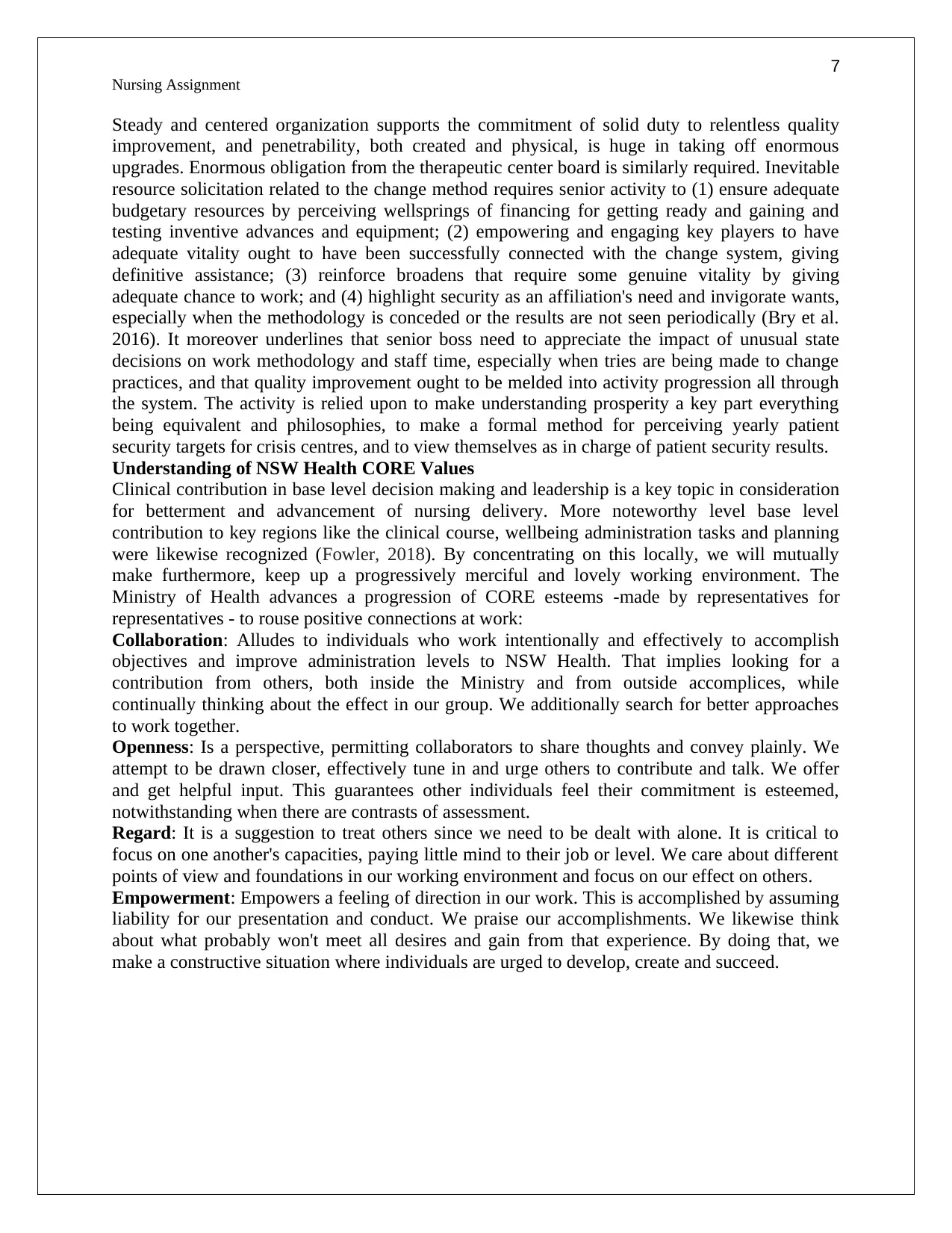
7
Nursing Assignment
Steady and centered organization supports the commitment of solid duty to relentless quality
improvement, and penetrability, both created and physical, is huge in taking off enormous
upgrades. Enormous obligation from the therapeutic center board is similarly required. Inevitable
resource solicitation related to the change method requires senior activity to (1) ensure adequate
budgetary resources by perceiving wellsprings of financing for getting ready and gaining and
testing inventive advances and equipment; (2) empowering and engaging key players to have
adequate vitality ought to have been successfully connected with the change system, giving
definitive assistance; (3) reinforce broadens that require some genuine vitality by giving
adequate chance to work; and (4) highlight security as an affiliation's need and invigorate wants,
especially when the methodology is conceded or the results are not seen periodically (Bry et al.
2016). It moreover underlines that senior boss need to appreciate the impact of unusual state
decisions on work methodology and staff time, especially when tries are being made to change
practices, and that quality improvement ought to be melded into activity progression all through
the system. The activity is relied upon to make understanding prosperity a key part everything
being equivalent and philosophies, to make a formal method for perceiving yearly patient
security targets for crisis centres, and to view themselves as in charge of patient security results.
Understanding of NSW Health CORE Values
Clinical contribution in base level decision making and leadership is a key topic in consideration
for betterment and advancement of nursing delivery. More noteworthy level base level
contribution to key regions like the clinical course, wellbeing administration tasks and planning
were likewise recognized (Fowler, 2018). By concentrating on this locally, we will mutually
make furthermore, keep up a progressively merciful and lovely working environment. The
Ministry of Health advances a progression of CORE esteems -made by representatives for
representatives - to rouse positive connections at work:
Collaboration: Alludes to individuals who work intentionally and effectively to accomplish
objectives and improve administration levels to NSW Health. That implies looking for a
contribution from others, both inside the Ministry and from outside accomplices, while
continually thinking about the effect in our group. We additionally search for better approaches
to work together.
Openness: Is a perspective, permitting collaborators to share thoughts and convey plainly. We
attempt to be drawn closer, effectively tune in and urge others to contribute and talk. We offer
and get helpful input. This guarantees other individuals feel their commitment is esteemed,
notwithstanding when there are contrasts of assessment.
Regard: It is a suggestion to treat others since we need to be dealt with alone. It is critical to
focus on one another's capacities, paying little mind to their job or level. We care about different
points of view and foundations in our working environment and focus on our effect on others.
Empowerment: Empowers a feeling of direction in our work. This is accomplished by assuming
liability for our presentation and conduct. We praise our accomplishments. We likewise think
about what probably won't meet all desires and gain from that experience. By doing that, we
make a constructive situation where individuals are urged to develop, create and succeed.
Nursing Assignment
Steady and centered organization supports the commitment of solid duty to relentless quality
improvement, and penetrability, both created and physical, is huge in taking off enormous
upgrades. Enormous obligation from the therapeutic center board is similarly required. Inevitable
resource solicitation related to the change method requires senior activity to (1) ensure adequate
budgetary resources by perceiving wellsprings of financing for getting ready and gaining and
testing inventive advances and equipment; (2) empowering and engaging key players to have
adequate vitality ought to have been successfully connected with the change system, giving
definitive assistance; (3) reinforce broadens that require some genuine vitality by giving
adequate chance to work; and (4) highlight security as an affiliation's need and invigorate wants,
especially when the methodology is conceded or the results are not seen periodically (Bry et al.
2016). It moreover underlines that senior boss need to appreciate the impact of unusual state
decisions on work methodology and staff time, especially when tries are being made to change
practices, and that quality improvement ought to be melded into activity progression all through
the system. The activity is relied upon to make understanding prosperity a key part everything
being equivalent and philosophies, to make a formal method for perceiving yearly patient
security targets for crisis centres, and to view themselves as in charge of patient security results.
Understanding of NSW Health CORE Values
Clinical contribution in base level decision making and leadership is a key topic in consideration
for betterment and advancement of nursing delivery. More noteworthy level base level
contribution to key regions like the clinical course, wellbeing administration tasks and planning
were likewise recognized (Fowler, 2018). By concentrating on this locally, we will mutually
make furthermore, keep up a progressively merciful and lovely working environment. The
Ministry of Health advances a progression of CORE esteems -made by representatives for
representatives - to rouse positive connections at work:
Collaboration: Alludes to individuals who work intentionally and effectively to accomplish
objectives and improve administration levels to NSW Health. That implies looking for a
contribution from others, both inside the Ministry and from outside accomplices, while
continually thinking about the effect in our group. We additionally search for better approaches
to work together.
Openness: Is a perspective, permitting collaborators to share thoughts and convey plainly. We
attempt to be drawn closer, effectively tune in and urge others to contribute and talk. We offer
and get helpful input. This guarantees other individuals feel their commitment is esteemed,
notwithstanding when there are contrasts of assessment.
Regard: It is a suggestion to treat others since we need to be dealt with alone. It is critical to
focus on one another's capacities, paying little mind to their job or level. We care about different
points of view and foundations in our working environment and focus on our effect on others.
Empowerment: Empowers a feeling of direction in our work. This is accomplished by assuming
liability for our presentation and conduct. We praise our accomplishments. We likewise think
about what probably won't meet all desires and gain from that experience. By doing that, we
make a constructive situation where individuals are urged to develop, create and succeed.
Paraphrase This Document
Need a fresh take? Get an instant paraphrase of this document with our AI Paraphraser
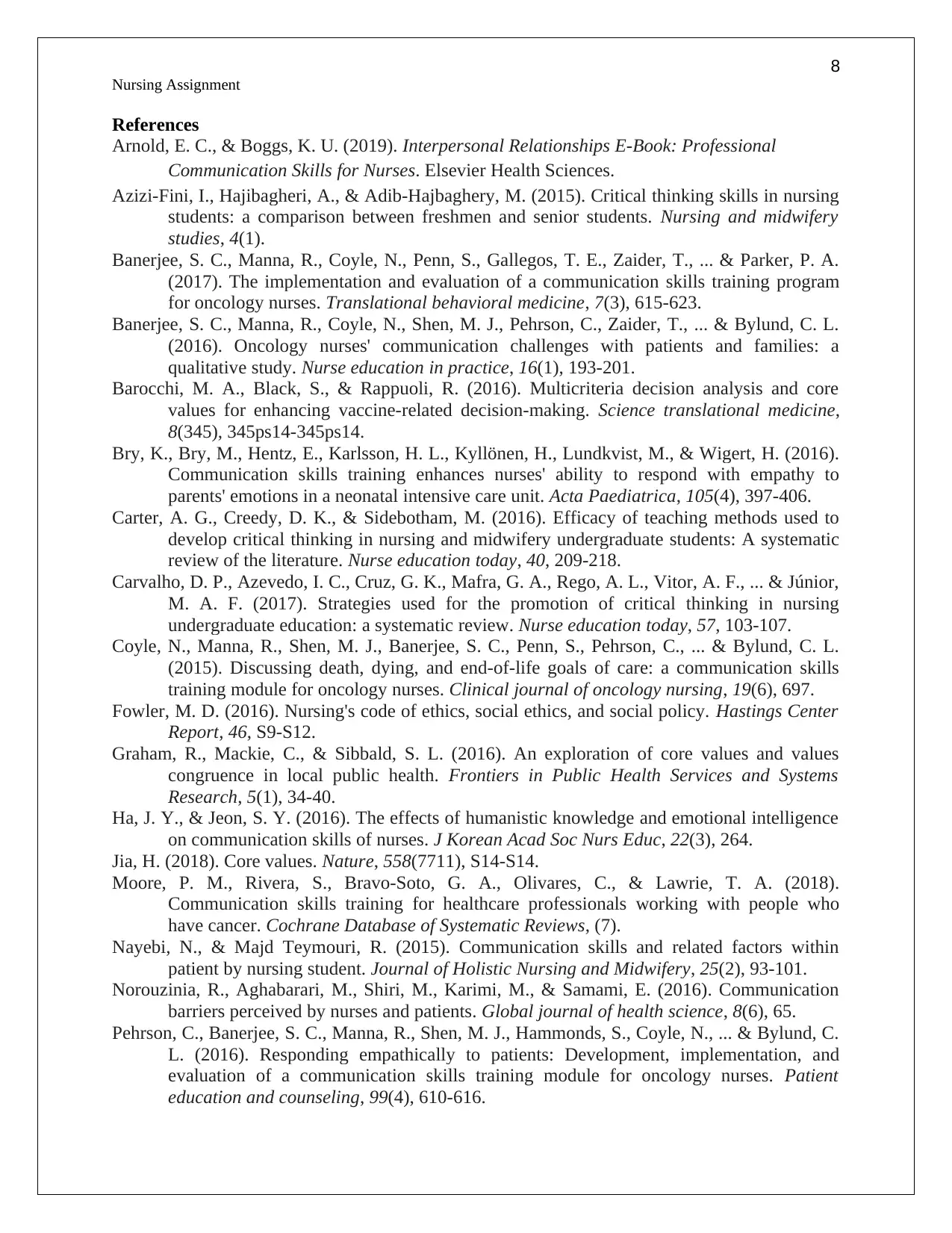
8
Nursing Assignment
References
Arnold, E. C., & Boggs, K. U. (2019). Interpersonal Relationships E-Book: Professional
Communication Skills for Nurses. Elsevier Health Sciences.
Azizi-Fini, I., Hajibagheri, A., & Adib-Hajbaghery, M. (2015). Critical thinking skills in nursing
students: a comparison between freshmen and senior students. Nursing and midwifery
studies, 4(1).
Banerjee, S. C., Manna, R., Coyle, N., Penn, S., Gallegos, T. E., Zaider, T., ... & Parker, P. A.
(2017). The implementation and evaluation of a communication skills training program
for oncology nurses. Translational behavioral medicine, 7(3), 615-623.
Banerjee, S. C., Manna, R., Coyle, N., Shen, M. J., Pehrson, C., Zaider, T., ... & Bylund, C. L.
(2016). Oncology nurses' communication challenges with patients and families: a
qualitative study. Nurse education in practice, 16(1), 193-201.
Barocchi, M. A., Black, S., & Rappuoli, R. (2016). Multicriteria decision analysis and core
values for enhancing vaccine-related decision-making. Science translational medicine,
8(345), 345ps14-345ps14.
Bry, K., Bry, M., Hentz, E., Karlsson, H. L., Kyllönen, H., Lundkvist, M., & Wigert, H. (2016).
Communication skills training enhances nurses' ability to respond with empathy to
parents' emotions in a neonatal intensive care unit. Acta Paediatrica, 105(4), 397-406.
Carter, A. G., Creedy, D. K., & Sidebotham, M. (2016). Efficacy of teaching methods used to
develop critical thinking in nursing and midwifery undergraduate students: A systematic
review of the literature. Nurse education today, 40, 209-218.
Carvalho, D. P., Azevedo, I. C., Cruz, G. K., Mafra, G. A., Rego, A. L., Vitor, A. F., ... & Júnior,
M. A. F. (2017). Strategies used for the promotion of critical thinking in nursing
undergraduate education: a systematic review. Nurse education today, 57, 103-107.
Coyle, N., Manna, R., Shen, M. J., Banerjee, S. C., Penn, S., Pehrson, C., ... & Bylund, C. L.
(2015). Discussing death, dying, and end-of-life goals of care: a communication skills
training module for oncology nurses. Clinical journal of oncology nursing, 19(6), 697.
Fowler, M. D. (2016). Nursing's code of ethics, social ethics, and social policy. Hastings Center
Report, 46, S9-S12.
Graham, R., Mackie, C., & Sibbald, S. L. (2016). An exploration of core values and values
congruence in local public health. Frontiers in Public Health Services and Systems
Research, 5(1), 34-40.
Ha, J. Y., & Jeon, S. Y. (2016). The effects of humanistic knowledge and emotional intelligence
on communication skills of nurses. J Korean Acad Soc Nurs Educ, 22(3), 264.
Jia, H. (2018). Core values. Nature, 558(7711), S14-S14.
Moore, P. M., Rivera, S., Bravo‐Soto, G. A., Olivares, C., & Lawrie, T. A. (2018).
Communication skills training for healthcare professionals working with people who
have cancer. Cochrane Database of Systematic Reviews, (7).
Nayebi, N., & Majd Teymouri, R. (2015). Communication skills and related factors within
patient by nursing student. Journal of Holistic Nursing and Midwifery, 25(2), 93-101.
Norouzinia, R., Aghabarari, M., Shiri, M., Karimi, M., & Samami, E. (2016). Communication
barriers perceived by nurses and patients. Global journal of health science, 8(6), 65.
Pehrson, C., Banerjee, S. C., Manna, R., Shen, M. J., Hammonds, S., Coyle, N., ... & Bylund, C.
L. (2016). Responding empathically to patients: Development, implementation, and
evaluation of a communication skills training module for oncology nurses. Patient
education and counseling, 99(4), 610-616.
Nursing Assignment
References
Arnold, E. C., & Boggs, K. U. (2019). Interpersonal Relationships E-Book: Professional
Communication Skills for Nurses. Elsevier Health Sciences.
Azizi-Fini, I., Hajibagheri, A., & Adib-Hajbaghery, M. (2015). Critical thinking skills in nursing
students: a comparison between freshmen and senior students. Nursing and midwifery
studies, 4(1).
Banerjee, S. C., Manna, R., Coyle, N., Penn, S., Gallegos, T. E., Zaider, T., ... & Parker, P. A.
(2017). The implementation and evaluation of a communication skills training program
for oncology nurses. Translational behavioral medicine, 7(3), 615-623.
Banerjee, S. C., Manna, R., Coyle, N., Shen, M. J., Pehrson, C., Zaider, T., ... & Bylund, C. L.
(2016). Oncology nurses' communication challenges with patients and families: a
qualitative study. Nurse education in practice, 16(1), 193-201.
Barocchi, M. A., Black, S., & Rappuoli, R. (2016). Multicriteria decision analysis and core
values for enhancing vaccine-related decision-making. Science translational medicine,
8(345), 345ps14-345ps14.
Bry, K., Bry, M., Hentz, E., Karlsson, H. L., Kyllönen, H., Lundkvist, M., & Wigert, H. (2016).
Communication skills training enhances nurses' ability to respond with empathy to
parents' emotions in a neonatal intensive care unit. Acta Paediatrica, 105(4), 397-406.
Carter, A. G., Creedy, D. K., & Sidebotham, M. (2016). Efficacy of teaching methods used to
develop critical thinking in nursing and midwifery undergraduate students: A systematic
review of the literature. Nurse education today, 40, 209-218.
Carvalho, D. P., Azevedo, I. C., Cruz, G. K., Mafra, G. A., Rego, A. L., Vitor, A. F., ... & Júnior,
M. A. F. (2017). Strategies used for the promotion of critical thinking in nursing
undergraduate education: a systematic review. Nurse education today, 57, 103-107.
Coyle, N., Manna, R., Shen, M. J., Banerjee, S. C., Penn, S., Pehrson, C., ... & Bylund, C. L.
(2015). Discussing death, dying, and end-of-life goals of care: a communication skills
training module for oncology nurses. Clinical journal of oncology nursing, 19(6), 697.
Fowler, M. D. (2016). Nursing's code of ethics, social ethics, and social policy. Hastings Center
Report, 46, S9-S12.
Graham, R., Mackie, C., & Sibbald, S. L. (2016). An exploration of core values and values
congruence in local public health. Frontiers in Public Health Services and Systems
Research, 5(1), 34-40.
Ha, J. Y., & Jeon, S. Y. (2016). The effects of humanistic knowledge and emotional intelligence
on communication skills of nurses. J Korean Acad Soc Nurs Educ, 22(3), 264.
Jia, H. (2018). Core values. Nature, 558(7711), S14-S14.
Moore, P. M., Rivera, S., Bravo‐Soto, G. A., Olivares, C., & Lawrie, T. A. (2018).
Communication skills training for healthcare professionals working with people who
have cancer. Cochrane Database of Systematic Reviews, (7).
Nayebi, N., & Majd Teymouri, R. (2015). Communication skills and related factors within
patient by nursing student. Journal of Holistic Nursing and Midwifery, 25(2), 93-101.
Norouzinia, R., Aghabarari, M., Shiri, M., Karimi, M., & Samami, E. (2016). Communication
barriers perceived by nurses and patients. Global journal of health science, 8(6), 65.
Pehrson, C., Banerjee, S. C., Manna, R., Shen, M. J., Hammonds, S., Coyle, N., ... & Bylund, C.
L. (2016). Responding empathically to patients: Development, implementation, and
evaluation of a communication skills training module for oncology nurses. Patient
education and counseling, 99(4), 610-616.
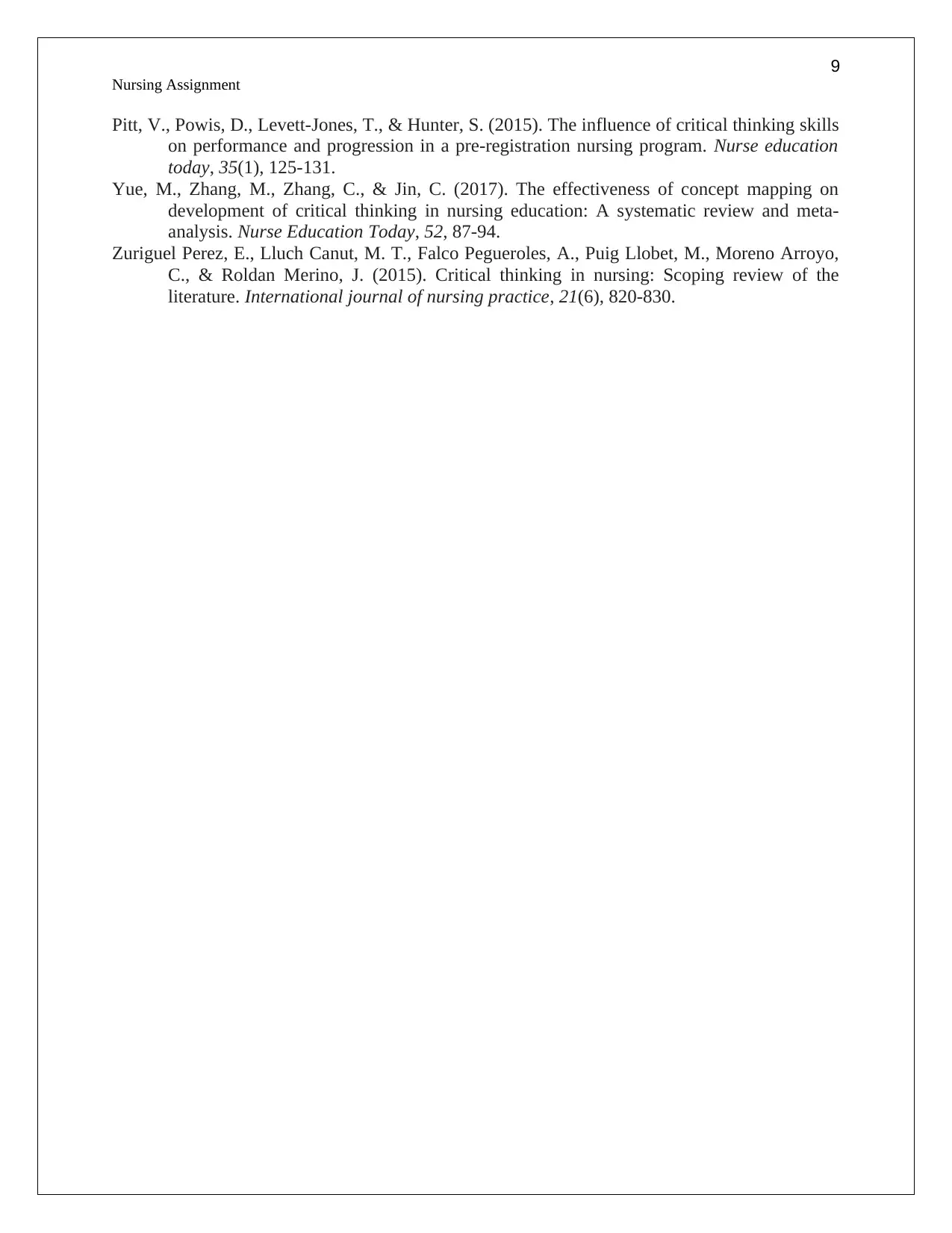
9
Nursing Assignment
Pitt, V., Powis, D., Levett-Jones, T., & Hunter, S. (2015). The influence of critical thinking skills
on performance and progression in a pre-registration nursing program. Nurse education
today, 35(1), 125-131.
Yue, M., Zhang, M., Zhang, C., & Jin, C. (2017). The effectiveness of concept mapping on
development of critical thinking in nursing education: A systematic review and meta-
analysis. Nurse Education Today, 52, 87-94.
Zuriguel Perez, E., Lluch Canut, M. T., Falco Pegueroles, A., Puig Llobet, M., Moreno Arroyo,
C., & Roldan Merino, J. (2015). Critical thinking in nursing: Scoping review of the
literature. International journal of nursing practice, 21(6), 820-830.
Nursing Assignment
Pitt, V., Powis, D., Levett-Jones, T., & Hunter, S. (2015). The influence of critical thinking skills
on performance and progression in a pre-registration nursing program. Nurse education
today, 35(1), 125-131.
Yue, M., Zhang, M., Zhang, C., & Jin, C. (2017). The effectiveness of concept mapping on
development of critical thinking in nursing education: A systematic review and meta-
analysis. Nurse Education Today, 52, 87-94.
Zuriguel Perez, E., Lluch Canut, M. T., Falco Pegueroles, A., Puig Llobet, M., Moreno Arroyo,
C., & Roldan Merino, J. (2015). Critical thinking in nursing: Scoping review of the
literature. International journal of nursing practice, 21(6), 820-830.
1 out of 9
Your All-in-One AI-Powered Toolkit for Academic Success.
+13062052269
info@desklib.com
Available 24*7 on WhatsApp / Email
![[object Object]](/_next/static/media/star-bottom.7253800d.svg)
Unlock your academic potential
© 2024 | Zucol Services PVT LTD | All rights reserved.